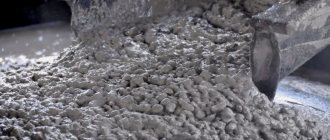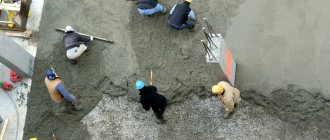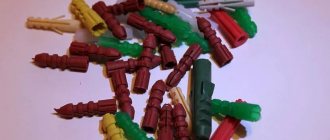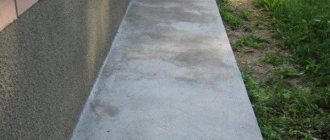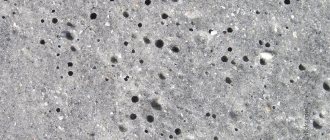Selection and calculation of cement
To build a durable and high-quality structure, it is very important to start with a strong foundation - a concrete foundation.
The characteristics of the soil, the weight of the structure, and the type of basement of the structure are factors that influence the choice of cement.
Preparing a concrete mixture is a rather complex and labor-intensive process; it is important to carefully select not only the base (crushed stone), but also the binding component (cement).
Calculation of components for one batch in a concrete mixer
1. Determine the yield coefficient of the concrete mixture:
2. Determine the consumption of concrete mixture components for one batch
- Cement for one batch = (Vb*β/1000)*C
- Water for one batch = (Vb*β/1000)*V
- Sand for one batch = (Vb*β/1000)*P
- Crushed stone for one batch = (Vb*β/1000)*Sh
where C, V, P, Shch is the consumption of materials per 1 m3 of concrete.
This calculation can be used to calculate the components of a concrete mixture for any vertical loading container (trough, mason's box) into which you will mix the mixture.
For the actual calculation in the concrete mixer, the mixture yield coefficient from the concrete mixer was taken equal to 0.44. To calculate the coefficient, a sample was compiled based on the responses of people from different construction forums who made batches with their own concrete mixers with different working volumes. © www.gvozdem.ru
If your mixture is too stiff, you can go in two ways to make it more flexible:
- adding a plasticizer;
- adding water and cement in the calculated W/C ratio.
Concrete hardening speed. Dependence on time and temperature - table
GOSTs, books, programs and calculators for calculating the composition of concrete
HOW to avoid discrepancies in the volume of the mixture?
- Check the mixture yield using the procedure described in ASTM C 138 at the very beginning of work. Repeat the tests if the problem occurs again. Make sure the measuring scale is accurate, the volume bucket is accurately calibrated, and that it and its cover plate are clean before testing. The volume in cubic meters is the quotient of the total weight of the mixture (in tons) by the density (in tons per cubic meter or kilograms per liter). The weight of a mixture is the weight of all its components. As a rough check, you can weigh the mixer full and empty, the difference will be the weight of the mixture.
- Accurately determine the volume using the formwork. Before completing large fills, carefully measure the remaining volume so that the volume of the last 2-3 cars is adjusted to the actual required volume. This will allow you to avoid waiting for half a cube when the supplier plant is already closed or the machines are scheduled for other fills. Order the correct quantity and re-evaluate once the pour is complete. Disposing of excess concrete has economic and environmental implications for the supplier.
- Estimate the amount of excess concrete required in excess of planned measurements by 4-10% due to underestimation of the pit volume, waste and other reasons. The use of uniform elements and sliding formwork allows you to more accurately estimate how much concrete will be required. The more simultaneous single applications of concrete (slabs, footings, walls and one-time fills around pipes) - the more contingency allowances will be required.
- Manufacture and fasten formwork to minimize deflection or distortion
- For slabs on the surface, carefully level and compact the concrete base.
Material consumption rates
Ideally, a building concrete mortar should consist of various fractions of crushed stone, i.e., pebbles of different sizes, “packed” as tightly as possible so that there is as little empty space between them as possible, and this empty space, in turn, should be filled with cement -sand mixture. This type of concrete will be the most durable, and besides, to prepare it you will need to prepare a minimum amount of mortar.
Scheme of fillers for cement mortar.
The main component of concrete is crushed stone. Suffice it to say that in a cube of concrete 0.80 m3 is crushed stone, and the rest is a mixture mixed with water, which fills the voids between the crushed stone, linking individual pebbles into a single monolith. Only the rules of arithmetic do not apply here, since such a mixture in 1 m3 of concrete solution will not be 0.20 m3, but much more - depending on the fraction of crushed stone, from 0.45 to 0.6 m3.
For concrete mix, it is very important which brand you use. Strictly speaking, the consumption of components can be different even for the same brand and depends on what parts the solution will be used for making. The ratio can be from 1:2 for the most critical components (foundation, beams, floors, etc.) to 1:5 for paths, blind areas and other structures that do not experience heavy loads on their surfaces. But still, the most common ratio of cement to sand, which satisfies most of the requirements for private and country house construction, is 1:3 or 1:4.
Here is the recommended consumption of materials for different grades of concrete:
- consumption for M100: cement – 220 kg, sand – 0.6 m3, crushed stone – 0.8 m3;
- consumption for M200 and M250: sand – 0.5 m3, crushed stone – 0.8 m3, cement, respectively, 280 and 330 kg;
- consumption for M300: cement – 380 kg, sand – 0.45 m3, crushed stone – 0.8 m3.
What should you consider before purchasing cement?
To correctly determine the consumption of concrete solution and the amount of components used for preparation, you should consider:
- requirements for the structure for which concrete is being prepared;
- brand of concrete and cement used to prepare the solution;
- characteristics of the ingredients used, which include the quality of sand and crushed stone fraction;
- proportions of components for the solution. The following proportion is usually used: 4 parts sand, 6 parts crushed stone, 1 part cement. Much here depends on the type of cement and its brand, what specific composition is needed and what quality;
- The consumption rate for one cubic meter of grade 150 solution is: cement - 200 kg, crushed stone (dolomite or limestone) - 980 kg, sand - 920 kg (quartz), water - 90-130 l. The end result should be 2100 kg.
Determination of concrete shrinkage coefficient
When designing large-sized buildings, all types of shrinkage processes are taken into account, which occur most intensively in the first 2-3 weeks. Then they slow down significantly and stop completely a year and a half after pouring. The main share of shrinkage changes is associated with loss of moisture by concrete.
A negative consequence of shrinkage processes: deformation of a concrete structure, which over time leads to cracking and gradually to a complete loss of performance characteristics of buildings and structures.
To prevent it, civil engineers carry out calculations in accordance with methodological instructions. When using modern materials and technologies, the concrete shrinkage coefficient is 0.97-1. This indicator corresponds to a linear change in the dimensions of the concrete element of 0.2-0.4 mm/m.
Regulatory documentation used in predicting shrinkage processes:
- SP 63.1330.2012, updated version of SNiP 52-01-2003.
- GOST 24544-81 “Concrete. Methods for determining shrinkage and creep deformations.”
- “Recommendations for taking into account creep and shrinkage of concrete when calculating concrete and reinforced concrete structures”, adopted by the Scientific Council of NIIZhB, 2014.
Artificially increasing the rate of hardening
The hardening time of cement mortar in cold weather increases greatly, but the time frame still remains limited. To speed up the procedure, various techniques have been developed.
BITUMAST Anti-frost additive for concrete
In modern construction, drying time can be accelerated by:
- adding additives;
- electric heating;
- increasing the required proportions of cement.
Using Modifiers
The easiest way to complete work on time even in winter is to use modifiers. When a certain proportion is added, the hydration period is reduced; when using some additives, hardening occurs even at -30°C.
Conventionally, additives that affect the rate of hardening are divided into several groups:
- type C – drying accelerators;
- type E – water-substituting additives with accelerated hardening.
The foundation hardening calculator and reviews show maximum effectiveness when potassium chloride is added to the solution. The material is consumed economically, since its mass fraction is up to 2%.
If you use type C concrete curing mixtures, you should take care of heating, since they do not protect against freezing.
Plasticizers and additives for concrete
It is recommended to take care of laying communications in the foundation or screed in advance, otherwise drilling holes will be required. Making communication holes after hardening will require a special tool and grinding of the concrete surface. The procedure is quite labor-intensive and reduces the strength of the structure.
Concrete heating
Mostly, a special cable is used to heat the composition, which converts electric current into heat. The technique provides the most natural way of hardening. An important factor is the need to follow the instructions for installing the wire. The method protects against liquid crystallization; there are also tools (hair dryer, welding machine) and thermal insulation to protect against freezing.
Increasing cement dosage
Increasing the cement concentration is used only with a slight decrease in temperature. It is important to increase the dosage in small quantities, otherwise the quality and durability will be significantly reduced.
Calculation of concrete mixture composition
In the article about concrete for foundations, we described in sufficient detail the characteristics of the concrete mixture and how they affect the reliability and strength of the monolith built from them. But the data presented there is clearly not enough to make the required amount of concrete with your own hands. When calculating the percentage composition of a concrete mixture, there are no trifles: you need to take into account the water-cement ratio (W/C), the characteristics of the aggregates (sand and crushed stone), and the brand of cement used. Where to start?
Let's say we need to get M300 grade concrete from M400 Portland cement. We look at the values presented in table 1. It can be seen from it that the water-cement ratio is 0.53. These tables are relevant for a concrete mixture prepared on the basis of crushed stone and sand, the particle size modulus of which does not exceed 2.5 - components with an average grain size. If we need to prepare a concrete solution without crushed stone filler, then 0.1 must be subtracted from the W/C value. In our case, it turns out that the water-cement ratio will be equal to 0.43. What does it mean? In the first case (W/C = 0.53), when using 50 kg of cement, it is necessary to add 50 × 0.53 = 26.5 liters of water to the mixture, in the second (W/C = 0.43) - 21.5 liters. But we just explained the term “water-cement ratio”. Let's move on to a specific example.
It is necessary to obtain: 10 cubes of concrete M300 with mobility P2 (cone slump up to 50 mm)
- crushed stone (maximum grain size – 25 mm), density – 2700 kg/m3
- medium sand, density – 2500 kg/m3
- Portland cement M400, the density of which in the water-cement mass is 3000 kg/m 3
Using Table 1, we find the W/C value to obtain the design grade of concrete M300. It is equal to 0.53. We look at the data in Table 2. It indicates that when using crushed stone with a maximum grain size of 25 mm, 195 liters of water (or 0.195 m 3 ) are required to prepare one cube of concrete. It turns out that for 1 cubic meter of concrete you will need: 195/0.53=368 kg of cement Next, you need to calculate how much volume per cubic meter fillers (sand and crushed stone) occupy: 1-((368/3000)+0.195)=0.682 m 3 or 682 liters Now, using the data in Table 2, we find the volumetric content of sand in the filler mixture. In our case it is equal to 46% or simply 0.46. Knowing it, it is easy to calculate the volume of sand: 682 × 0.46 = 313.7 liters or 0.314 m 3 We subtract the volume of sand from the total volume of fillers and get the volume of crushed stone: 682-313.7 = 368.3 liters or 0.368 m 3 Knowing the volumes fillers and density, it is easy to calculate their mass. So, for sand it will be: 0.314×2500=785 kg, for crushed stone - 0.368×2700=993.6 kg.
In total, to prepare one cubic meter of concrete mix of design grade M300 from Portland cement M400 you will need:
368 kg of cement, 195 liters of water, 785 kg of sand, 993.6 kg of crushed stone
To prepare ten cubes, the obtained values must be multiplied by 10. This data is used to adjust the calculation of the foundation. You can also express the mass ratio of cement, sand and crushed stone:
Using Table 3, we made sure that the calculated mass of cement is not less than the tabulated values indicated for the preparation of M300 concrete mixture with a cone slump of up to 50 mm (P2) from M400 cement.
WHY do volume problems occur?
Most volume complaints relate to actual or anticipated shortages of concrete volume. They must be assessed using a concrete mix weight test. Volume shortages occur when the wrong concrete is ordered or due to the above factors. If the weight measurement and volume calculation show a lack of weight, the volume must be adjusted. Individual volume shortages may be caused by the following reasons:
- incorrect calculation of the volume or thickness of the slab, while the actual thickness differs by centimeters. For example, a 3mm error for a 10cm slab would mean a 3 percent shortfall, or 1 cubic meter for every 30m3 of concrete.
- deflection or bending of the formwork due to concrete pressure,
- non-standard concrete preparation, pouring onto a rough surface, subsidence of the concrete under the weight of the concrete.
- using a small amount of concrete along a long pour for other purposes.

